Elegant, redheaded Valerie Hobson (1917-1998) was a great beauty who became an impressive actress. The British actress landed some very choice roles in the later 1940s, and was at her best in those films in which she could exercise her comedy talent.
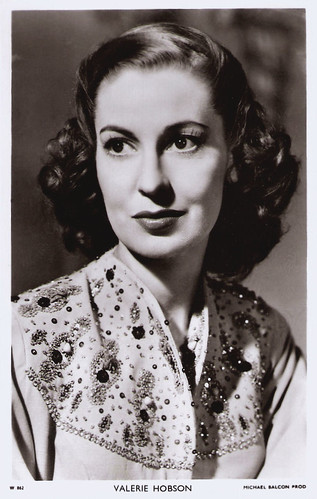
British postcard in the Picturegoer series, London, no. W 862. Photo: Michael Balcon Prod.
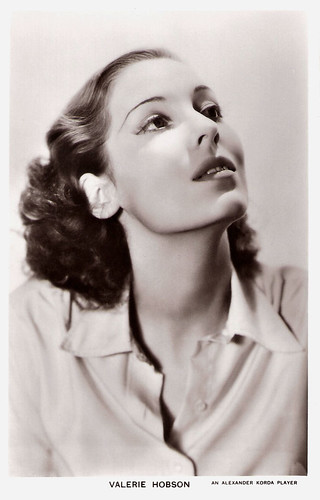
British postcard in the Picturegoer Series, no. 1210. Photo: Alexander Korda.
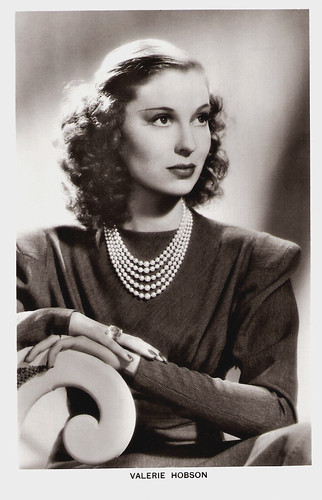
British postcard in the Picturegoer series, London, no. 1350.

British postcard in the Picturegoer series, London, no. 1454.
Valerie Hobson was born Babette Valerie Louise Hobson in Larne, Ireland, UK (now Northern Ireland, UK) in 1917. She was the daughter of a British Army officer. She originally trained as a dancer but she caught scarlet fever, and during the long days in bed gained two inches. Unfortunately, she thus outgrew her strength. She was forced to abandon dancing and went to study at the Royal Academy of Dramatic Arts.
She had barely begun her studies at the RADA, when at 16, she made her stage début as Grace in Ball at the Savoy at the Drury Lane Theatre. It was a small part which was specially written into the show for her by Oscar Hammerstein II, and one which gave her the opportunity to do a little singing and dancing as well as acting. Symmetrically enough, at the Drury Lane she would also make her final acting appearance as the governess in The King and I (1954).
Her film career soon began in modest British films. She made her credited film debut in Eyes of Fate (Ivar Campbell, 1933), and appeared in Badger's Green (Adrian Brunel, 1934). When she was only seventeen Hobson was given a contract by Universal Pictures in Hollywood.
There she appeared as Baroness Frankenstein in the classic horror film Bride of Frankenstein (James Whale, 1935) with Boris Karloff and Colin Clive, taking over the role from Mae Clarke, who had played it in the original Frankenstein (James Whale, 1931).
That same year Hobson also appeared opposite Henry Hull in Werewolf of London (Stuart Walker, 1935), the first Hollywood werewolf movie, predating The Wolf Man (George Waggner, 1941) by six years.
After her return to England, there were a few more minor films before Technicolor made her a star in Alexander Korda's production The Drum (Zoltan Korda, 1938) starring Sabu.
She then had successes as a wisecracking reporter in the comedy thriller This Man is News (David MacDonald, 1938) opposite Barry K. Barnes and its sequel, This Man in Paris (David MacDonald, 1939). Both were produced by Anthony Havelock-Allan whom she married in 1939.
For her favourite director, Michael Powell, she was both sexy and resourceful in two popular wartime spy thrillers opposite Conrad Veidt, The Spy in Black (1939) and Contraband (1940).
David Absalom at British Pictures describes her thus: "She was typecast as the Iron Maiden of British cinema. Always perfectly groomed, nicely spoken, and with the sort of toughness that built the Empire. You can imagine her surviving The Black Hole of Calcutta without a hair out of place. You can't imagine her enjoying a 'knock-knock' joke. As a type it's gone out of fashion, but Valerie Hobson was cinema's best exponent of it at a time when the type was in demand, and therefore got to appear in some of the best films this country has ever produced."

British postcard in the Film Partners Series, no. PC 284. Photo: Paramount British. Publicity still for This Man in Paris (David MacDonald, 1939) with Barry K. Barnes.

British postcard in Our Postcard Series.

Dutch postcard. Photo: J. Arthur Rank.
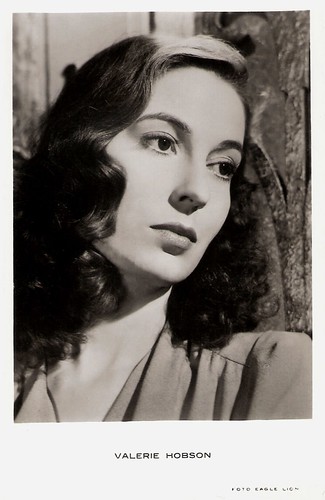
Dutch postcard by Hemo. Photo: Eagle Lion.
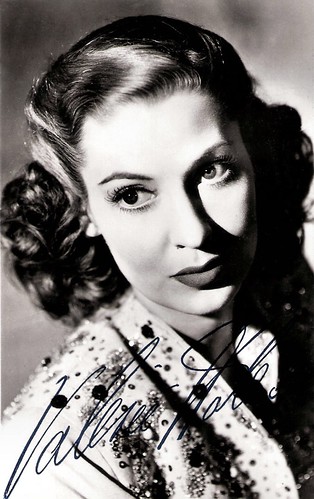
British autograph card.
During the latter half of the 1940s Valerie Hobson played several memorable roles. She was the adult Estella in Great Expectations (David Lean, 1946) with John Mills, the passionate, ambitious heroine of Blanche Fury (Marc Allégret, 1947) opposite Stewart Granger, and as the selfish mother of John Howard Davies in the haunting The Rocking Horse Winner (Anthony Pélissier, 1949).
She was perfect as the refined, virtuous Edith D'Ascoyne in the black comedy Kind Hearts and Coronets (Robert Hamer, 1949). David Absalom calls it 'the greatest of the Ealing comedies': "It was another wonderful performance as the lady so gracious, so understanding, so perfect that you could easily see why Dennis Price fell for her but still couldn't stand her for too long."
In 1952 she divorced Anthony Havelock-Allan, and married in 1954 John Profumo, then a junior minister in the Churchill government. Her last film, Monsieur Ripois/Knave of Hearts (René Clément, 1954) starring Gérard Philipe, showed her again as a mistress of subtle comedy.
She retired as an actress after starring as the governess, Anna, in the 1953 stage production of the musical The King and I in London. That role, The Daily Telegraph said in their obituary, was her greatest success, and "as an actress, she knew, like Garbo, when to quit." Then at Profumo's insistence, she retired from her acting career.
Years after her retirement she was reluctantly thrust back into the spotlight. In 1963 Profumo was forced to resign as minister for war, following revelations he had lied to the House of Commons about his affair with call girl Christine Keeler. The sex scandal brought down Britain's Conservative Government once it was revealed that Keeler was also involved with a Soviet military attache. Valerie Hobson stood by her husband during the scandal, and for the remainder of her life they worked together on behalf of mentally handicapped children and lepers.
Hobson's eldest son, Simon Anthony Clerveaux Havelock-Allan was born in 1944 with Down's Syndrome. This tragedy had reduced Hobson to a 'zombie' state for an entire year, during which she hardly spoke. The child became a resident patient at a Rudolf Steiner School for the handicapped, and she continued to love him devotedly. She later had two more sons, Mark Havelock-Allan (1951) (now His Honour Judge Sir Mark Havelock-Allan QC), and David Profumo (1955), who wrote a book, Bringing the House Down, about his father's scandal.
Valerie Hobson died in London in 1998, when she stopped taking her medication which led to a heart attack.
Trailer of Bride of Frankenstein (1935). Source: Movieclips (YouTube).
Scene with Conrad Veidt in Contraband (1940). Source: quixotandovideos (YouTube).
Trailer Great Expectations (1946). Source: Andy Beezer (YouTube).
Trailer of Kind Hearts and Coronets (1949). Source: Film365 (You Tube).
Sources: Brian McFarlane (Encyclopedia of British Film), David Absalom (British Pictures), Hal Erickson (AllMovie), Eric Pace (The New York Times), BritMovie, Lenin Imports, Chalybs (IMdb), The Powell & Pressburger Pages, Wikipedia, and IMDb.

British postcard in the Picturegoer series, London, no. W 862. Photo: Michael Balcon Prod.

British postcard in the Picturegoer Series, no. 1210. Photo: Alexander Korda.

British postcard in the Picturegoer series, London, no. 1350.

British postcard in the Picturegoer series, London, no. 1454.
Baroness Frankenstein
Valerie Hobson was born Babette Valerie Louise Hobson in Larne, Ireland, UK (now Northern Ireland, UK) in 1917. She was the daughter of a British Army officer. She originally trained as a dancer but she caught scarlet fever, and during the long days in bed gained two inches. Unfortunately, she thus outgrew her strength. She was forced to abandon dancing and went to study at the Royal Academy of Dramatic Arts.
She had barely begun her studies at the RADA, when at 16, she made her stage début as Grace in Ball at the Savoy at the Drury Lane Theatre. It was a small part which was specially written into the show for her by Oscar Hammerstein II, and one which gave her the opportunity to do a little singing and dancing as well as acting. Symmetrically enough, at the Drury Lane she would also make her final acting appearance as the governess in The King and I (1954).
Her film career soon began in modest British films. She made her credited film debut in Eyes of Fate (Ivar Campbell, 1933), and appeared in Badger's Green (Adrian Brunel, 1934). When she was only seventeen Hobson was given a contract by Universal Pictures in Hollywood.
There she appeared as Baroness Frankenstein in the classic horror film Bride of Frankenstein (James Whale, 1935) with Boris Karloff and Colin Clive, taking over the role from Mae Clarke, who had played it in the original Frankenstein (James Whale, 1931).
That same year Hobson also appeared opposite Henry Hull in Werewolf of London (Stuart Walker, 1935), the first Hollywood werewolf movie, predating The Wolf Man (George Waggner, 1941) by six years.
After her return to England, there were a few more minor films before Technicolor made her a star in Alexander Korda's production The Drum (Zoltan Korda, 1938) starring Sabu.
She then had successes as a wisecracking reporter in the comedy thriller This Man is News (David MacDonald, 1938) opposite Barry K. Barnes and its sequel, This Man in Paris (David MacDonald, 1939). Both were produced by Anthony Havelock-Allan whom she married in 1939.
For her favourite director, Michael Powell, she was both sexy and resourceful in two popular wartime spy thrillers opposite Conrad Veidt, The Spy in Black (1939) and Contraband (1940).
David Absalom at British Pictures describes her thus: "She was typecast as the Iron Maiden of British cinema. Always perfectly groomed, nicely spoken, and with the sort of toughness that built the Empire. You can imagine her surviving The Black Hole of Calcutta without a hair out of place. You can't imagine her enjoying a 'knock-knock' joke. As a type it's gone out of fashion, but Valerie Hobson was cinema's best exponent of it at a time when the type was in demand, and therefore got to appear in some of the best films this country has ever produced."

British postcard in the Film Partners Series, no. PC 284. Photo: Paramount British. Publicity still for This Man in Paris (David MacDonald, 1939) with Barry K. Barnes.

British postcard in Our Postcard Series.

Dutch postcard. Photo: J. Arthur Rank.

Dutch postcard by Hemo. Photo: Eagle Lion.

British autograph card.
Sex Scandal
During the latter half of the 1940s Valerie Hobson played several memorable roles. She was the adult Estella in Great Expectations (David Lean, 1946) with John Mills, the passionate, ambitious heroine of Blanche Fury (Marc Allégret, 1947) opposite Stewart Granger, and as the selfish mother of John Howard Davies in the haunting The Rocking Horse Winner (Anthony Pélissier, 1949).
She was perfect as the refined, virtuous Edith D'Ascoyne in the black comedy Kind Hearts and Coronets (Robert Hamer, 1949). David Absalom calls it 'the greatest of the Ealing comedies': "It was another wonderful performance as the lady so gracious, so understanding, so perfect that you could easily see why Dennis Price fell for her but still couldn't stand her for too long."
In 1952 she divorced Anthony Havelock-Allan, and married in 1954 John Profumo, then a junior minister in the Churchill government. Her last film, Monsieur Ripois/Knave of Hearts (René Clément, 1954) starring Gérard Philipe, showed her again as a mistress of subtle comedy.
She retired as an actress after starring as the governess, Anna, in the 1953 stage production of the musical The King and I in London. That role, The Daily Telegraph said in their obituary, was her greatest success, and "as an actress, she knew, like Garbo, when to quit." Then at Profumo's insistence, she retired from her acting career.
Years after her retirement she was reluctantly thrust back into the spotlight. In 1963 Profumo was forced to resign as minister for war, following revelations he had lied to the House of Commons about his affair with call girl Christine Keeler. The sex scandal brought down Britain's Conservative Government once it was revealed that Keeler was also involved with a Soviet military attache. Valerie Hobson stood by her husband during the scandal, and for the remainder of her life they worked together on behalf of mentally handicapped children and lepers.
Hobson's eldest son, Simon Anthony Clerveaux Havelock-Allan was born in 1944 with Down's Syndrome. This tragedy had reduced Hobson to a 'zombie' state for an entire year, during which she hardly spoke. The child became a resident patient at a Rudolf Steiner School for the handicapped, and she continued to love him devotedly. She later had two more sons, Mark Havelock-Allan (1951) (now His Honour Judge Sir Mark Havelock-Allan QC), and David Profumo (1955), who wrote a book, Bringing the House Down, about his father's scandal.
Valerie Hobson died in London in 1998, when she stopped taking her medication which led to a heart attack.
Trailer of Bride of Frankenstein (1935). Source: Movieclips (YouTube).
Scene with Conrad Veidt in Contraband (1940). Source: quixotandovideos (YouTube).
Trailer Great Expectations (1946). Source: Andy Beezer (YouTube).
Trailer of Kind Hearts and Coronets (1949). Source: Film365 (You Tube).
Sources: Brian McFarlane (Encyclopedia of British Film), David Absalom (British Pictures), Hal Erickson (AllMovie), Eric Pace (The New York Times), BritMovie, Lenin Imports, Chalybs (IMdb), The Powell & Pressburger Pages, Wikipedia, and IMDb.
No comments:
Post a Comment